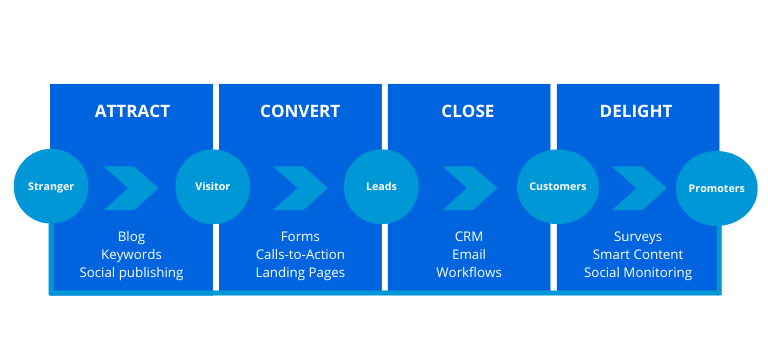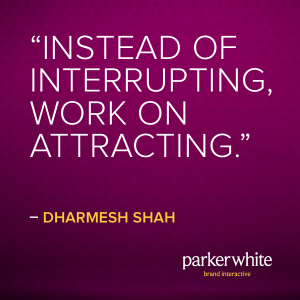What is inbound marketing and why should you care?
Unfortunately, even in 2022, annoying intrusive marketing tactics are still not a thing of the past. We know these all too well ourselves. Frustrating, isn’t it? Fortunately, there is something that works a lot better. It’s called inbound marketing. But what exactly is inbound marketing, and why should you care?
Inbound marketing is a methodology that helps you attract visitors by providing the right information in the right place and time in their buyer journey. This is a customer centric way of doing marketing.
Let’s make it a bit more concrete. In inbound marketing, you use tactics like SEO, email and content marketing to attract the right visitors. further down the funnel, you convert these visitors into leads, and leads into customers. The content you use has to convince people, inspire trust and incite action. This could be a newsletter registration or making an online purchase for example. In the end, inbound marketing is a smarter way of doing marketing because it’s less intrusive and it builds trust.
What is inbound marketing not?
Inbound marketing is the complete opposite of traditional outbound marketing. Examples of outbound marketing are radio spots, newspaper ads or tv commercials. These are impersonal tactics and are almost never relevant or personalized for the people who get to see or hear them.
Also, don’t think that inbound marketing and content marketing are the same. They are quite different concepts. You implement content marketing in your inbound marketing process. With the right keywords, you attract the right visitors during their buyer journey. You use relevant content to convince people, guide them along their buyer journey and help them making a purchase decision, hopefully in favor of your organization. Content is an important part of the inbound marketing methodology.
An example of inbound marketing
Let’s illustrate this with an example. Suppose you’ve just bought a house and moved all your stuff. Chances are you need to paint or you need new curtains. So you start looking for interior design trends, where to buy paint and what your interior design is going to cost. You will probably click on the links that appear on page 1 of the search results. These companies have created content and posted it in on several channels. They got you to click through to their website based on keywords that were relevant to you. Half a year earlier you were not even thinking about paint or curtains at all. It wasn’t relevant then, but it is now. And eventually you bought paint and curtains somewhere based on what you found online. This is how inbound marketing works.
Thee inbound marketing phases
The inbound marketing methodology consists of 4 phases. This is what Hubspot calls them:
- Attract
- Convert
- Close
- Delight

1 - Attract
The purpose of the attract phase is to attract people that are interested in what you are doing. You make sure that they can find you online by offering content that includes keywords relevant to them. You optimize your website for search engines, by publishing great content on your website and by promoting it through social media. Content plays a crucial role here.
By doing keyword research you can find out what content you need to work on. Who are you are buyer personas and what is important to them? What search terms do they use? And what content can you provide in return?
2 - Convert
In the convert phase, you convert your visitors into leads. You encourage them to do something specific: register for a newsletter, download a whitepaper … If you can offer them something they get value from, your visitors will give you some information in exchange. Common techniques to do this are the call to action, landing pages and forms.
3 - Close
Of course, you want to convert your leads from the previous phase into paying customers. This happens in the close phase. You need to realize that most of your leads are not yet ready to buy. The purpose of this phase is to make them ready for a purchase.
With emails, you make sure your leads learn more about topics relevant to them. With each email, you build trust, until they are ready to buy. This process is called lead nurturing. Once your leads are ready, your sales team takes over. With all the information they have about your leads, they can make sales calls and close the deal.
4 - Delight
Inbound marketing doesn’t stop when someone. becomes a customer though. You now have a paying customer, but it is also important to keep them satisfied. The delight phase serves this purpose. It’s much easier to keep an existing customer satisfied than finding new ones.
To reach the desired level of customer satisfaction, you can proactively send them relevant information about your products and services in this phase. Information that helps them get the most out of whatever it is they are buying from you.
Satisfied customers will recommend your organization to their network. This will bring new visitors to your website, that in turn also become leads, and so on. The whole process begins again.
Why is inbound marketing relevant to you?
We already mentioned it: outbound doesn’t work well anymore. It often generates more frustration than clicks. B2B as well as B2C consumers are very critical. They know exactly what they want and go searching for content themselves. The power no longer belongs to the seller, but to the buyer. ‘One size fits all’ messages through mass media no longer cut it. Today, people want to find relevant and personalized content when they need it.
As a marketeer or manager, it is your task to develop a strategy that allows you to deal with this. Inbound marketing provides answers to questions that many companies today struggle with. It is about building a relationship and trust with potential customers. Instead of frustrating them with irrelevant messages, you need to provide them with relevant content. Content that really helps them solve a problem.


We are convinced that inbound marketing will only be more important in the future. In a fast-changing world, new tools are invented, others disappear. You should see inbound marketing not as a tool, but as a marketing methodology that helps you sustainably grow your business.
Ready to get started? You can read more about this topic in our website, or you can contact us for a short video call. We are happy to help.
Get More Customers with Inbound Marketing!
This free checklist will help you get the most out of your inbound marketing campaigns






